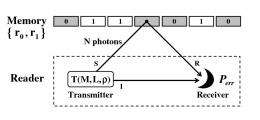March 14, 2011 feature
Using quantum methods to read classical memories offers surprising advantages

(PhysOrg.com) -- Currently, the data stored in classical digital memories such as CDs, DVDs, and barcodes is read by classical light. But as a new study shows, using quantum light to read these classical memories can bring surprising advantages. Quantum light can read digital data using very few photons, an ability that could lead to faster digital readers and optical memories with larger storage capacities than before.
Quantum physicist Stefano Pirandola from the University of York, UK, has published the study on the quantum readout of classical memories in a recent issue of Physical Review Letters.
"This is the first demonstration showing that the use of nonclassical light is beneficial for the readout of digital memories, reminiscent of current optical storage devices," Pirandola told PhysOrg.com.
As Pirandola explains in his study, there is an important difference between classical light – the light that is used in practically all of today’s technology applications – and quantum light. In classical light, the states of the electromagnetic field can be decomposed as probabilistic sums of coherent states. In contrast, when this decomposition is not possible, the states of an electromagnetic field are considered to be nonclassical (quantum). Important examples of nonclassical states are those that are entangled, in particular those with Einstein-Podolsky-Rosen (EPR) correlations. When two modes of light are described by these kinds of entangled states, their position and momentum "quadratures" are extremely correlated with each other.
In the proposed method, a classical digital memory consists of many reflective cells, each of which has two possible reflectivities that represent the states 0 and 1 (the two values of a bit). To read the memory, light is irradiated on the cells, and a detector measures the reflected light to determine each cell’s state. Currently, classical light is used for these kinds of memories. However, when its energy is decreased, classical light can only retrieve a limited amount of information from each cell.
Quantum light, on the other hand, doesn’t face the theoretical limits that classical light does. Pirandola’s calculations showed that EPR transmitters (those that use quantum light) can retrieve much more information than classical transmitters in the regime of few photons. He calculates that the enhancement provided by quantum light can be quite large – even up to 1 bit per cell, which corresponds to the extreme situation where only quantum light can retrieve information, and classical light cannot retrieve any information at all.
Since quantum light can read digital information with significantly fewer photons than classical light, it can greatly reduce the reading time of the memory, resulting in higher data transfer rates. For instance, quantum light could increase the rotational speed of a DVD in such a way that only a few photons are irradiated in each data sector. Alternatively, if the reading time is fixed, the quantum light method can offer increased storage capacity compared to reading with classical light.
“The enhancement will be clearer in the future once quantum technology provides more efficient sources of quantum light,” Pirandola said. “Using quantum light, we could read memories using a few photons per bit, while today we use around 1010 photons per bit. This can give an idea of the possible improvement, but I am not able to give good estimates.”
Pirandola also shows that EPR transmitters can be used in error-corrected memory models, in which each bit of information is stored in multiple cells to provide nearly flawless data readout. In contrast, low-energy classical transmitters are basically useless in this situation because they require many more cells for retrieving a single bit of information.
One other possible advantage for reading with quantum light lies in photodegradable organic memories, which contain confidential information. Faint quantum light may be able to read this data since it uses so few photons, whereas energetic classical light would destroy these memories.
“The challenging part [of experimentally demonstrating this concept] is clearly in the [light] source which should be fast and efficient,” Pirandola said. “Despite this, a pilot experiment is within the catch of current technology.”
More information: Stefano Pirandola. “Quantum Reading of a Classical Digital Memory.” Physical Review Letters 106, 090504 (2011). DOI:10.1103/PhysRevLett.106.090504
Copyright 2010 PhysOrg.com.
All rights reserved. This material may not be published, broadcast, rewritten or redistributed in whole or part without the express written permission of PhysOrg.com.

















